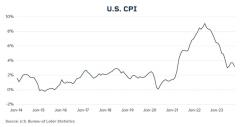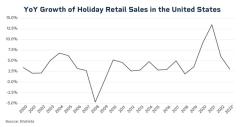By Bob Iaccino, for CME Group
AT A GLANCE
- Holiday season sales can account for 20% to 40% of total annual sales for some retailers.
- When reporting Q3 2023 earnings, retail giants Target and Walmart warned about the health of the U.S. consumer moving into the holiday season.
When considering the broad picture of consumer spending in the United States, many assume the holiday season accounts for a significant percentage of total consumer spending, but it’s not as much as you might initially think.
That’s because consumer spending includes retail goods and services, healthcare, housing, and other categories. When you look at total consumption, the percentage attributed to the holiday season is much smaller since consumer spending encompasses many services and goods beyond just holiday-related retail items.
However, when considering retail alone, holiday season sales are indeed substantial, and for many retailers, those seasonal sales can be anywhere from 20% to 40% of total annual sales. Given that U.S. consumers have suffered through multiple years of accelerating inflation, it is reasonable to posit that they might take a break this year and slow their traditional holiday spending.

Looking at U.S. Consumer Price Index data, you can see that the growth rate of inflation accelerated in late 2020 and didn’t start to taper off until late 2021. Even though there has been some relief since, prices are still rising. When we hear that CPI is falling, it’s important to remember that CPI measures the growth rate of prices. So until CPI is negative, prices are not falling. They are rising at a slower rate than at the time of the last CPI reading.

Now let’s look at year-over-year percentage change in holiday sales (*a consensus estimate is used for 2023). Notice that from 2020 to 2022, the chart seems to be correlated with that of CPI. The correlation comes from the fact that sales are reported in dollars, not units, so when prices rise as much as they did during those two years, revenues rise even if unit sales fall.
So, is holiday spending going to suffer in 2023? It depends on who you ask. Cameron Dawson, Chief Investment Officer at NewEdge Wealth, answered my question about 2023 holiday sales. “It’s this middle ground of not being gangbusters but also not falling off a cliff,” Dawson said. “I recently did a big deep dive on the consumer. The consumer balance sheet is ok, but the income statement is getting pinched by inflation/debt servicing costs. The question is, if unemployment increases, how quickly will the balance sheet fray?”
On the other side, retail giants Target and Walmart reported earnings the week of Nov. 13, and while both sets of numbers were good, they both warned about the health of the U.S. consumer moving forward. Target forecasted a weak holiday season as customers continue to forgo discretionary purchases like furniture, electronics, and some types of clothing. Target expects sales to decline by mid-single digits this holiday season.
Walmart CFO John David Rainey said customers still use more discretion in this inflationary environment and are waiting for big sales during Black Friday and Cyber Monday. “This gives us reason to think slightly more cautiously about the consumer versus 90 days ago,” Rainey said.
Given that consumers will spend, looking at what may be different this time is helpful.
- Reduced Purchasing Power: Inflation erodes the purchasing power of money. This might result in reduced spending during the holiday season, with many consumers becoming more selective about their purchases or seeking cheaper alternatives.
- Prioritization of Essential Goods: With rising prices, there’s a tendency to prioritize essential goods over non-essential or luxury items. That can mean a shift in holiday shopping patterns from indulgent gifts to more practical or essential items.
- Discount Hunting: To counteract the effect of inflation, many consumers might wait for significant discounts or sales before making purchases. Black Friday, Cyber Monday, and other promotional events might see heightened activity as shoppers look for deals that give them better value for their money.
- Delayed Purchases: Using the holidays as an excuse to “upgrade” may not happen. Electronics, buying new apparel, or other non-urgent expenses might be postponed to a later date when financial conditions seem more stable.
- Brand Disloyalty: Financial stress can strain brand loyalty. Even if consumers have traditionally preferred specific brands, the pressure of rising prices might push them to explore cheaper or local alternatives.
- Increased Use of Credit: Some consumers might be tempted to rely more heavily on credit cards or loans to finance holiday purchases. However, a short-term bump in sales can lead to problems for consumers if they accumulate too much debt.
- More Online Shopping: Due to reduced overhead costs, online platforms often provide price comparisons, deals, and sometimes lower prices than brick-and-mortar stores. Prolonged inflation might further drive consumers online in search of better deals.






